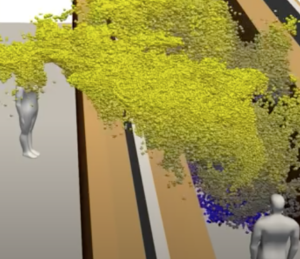The daily tick of two numbers has become a national obsession. We count deaths and cases like some sort of pandemic weather report, a grim reminder of an epidemiological perfect storm. But the report on these counters is incomplete. Reducing the pandemic to two numbers conveys the subliminal message that the only really bad outcome is death. It opens the door for the President to suggest, “Now we have tested almost 40m people. By so doing, we show cases, 99% of which are totally harmless.” That’s a bit like assessing the severity of the weather by counting tornadoes.
A recent paper from the Journal of the American Medical Association gives us some sense of the full impact of pandemic weather. Italian researchers found that patients hospitalized for COVID-19 continued to have significant symptoms long after discharge. In interviews recorded months after the onset of symptoms, 53% of previously hospitalized patients reported chronic fatigue, 43% continued to have difficulty breathing, and 27% had joint pain. 87% had at least one persistent symptom from a list of 17 and more than half had at least three of those symptoms.
The respiratory effects of COVID-19 are well known and at least some of the lung injury is permanent. Beyond the lungs, the disease causes widespread devastation to the body including injury to the kidneys, the heart, and the brain, some of which is due to widespread clotting. It is not clear to what extent these effects are permanent, but the Italian paper raises serious concerns about their reversibility.
Long Term COVID-19 symptoms in the US
The CDC has estimated that 21-31% of infections result in hospitalization. If, to be conservative, we take the lower end of that range and assume that 21% of the 3,420,000 infections reported in the United States result in hospitalization, we would have 720,000 inpatients. Approximately 580,000 will be discharged (after subtracting 140,000 deaths). Applying the rates of long-term symptoms from the Italian date paints the following grim picture.
| Symptom | US Cases |
| Any | 507,000 |
| Fatigue | 308,000 |
| Difficulty Breathing | 252,000 |
| Joint Pain | 158,000 |
| 3 or More | 319,000 |
Note that the paper lists many more long-term symptoms, including chest pain, cough, loss of smell or taste, headaches, loss of appetite, muscle aches, and Sjorgren’s syndrome (an auto-immune disease with multiple symptoms of its own).
Conservatively estimated, half a million Americans already have long term, potentially permanent, effects from COVID-19. This is in addition to the trauma and financial impact of hospitalization and ICU care for at least 700,000 and 164,000 people (respectively). Even those who are not hospitalized often report serious symptoms for a month or more. We are still coming to understand this disease and don’t even know all of its symptoms. The recently recognized relationship between SARS-CoV-2 and a potentially fatal auto-immune disease in young children is particularly worrisome. These new results also demonstrate that its long-term consequences have yet to be revealed.
So, beware the illusion of simplicity created by the dozens of counters that track the course of disaster. COVID-19 is a devilishly complicated disease with serious consequences we have yet to fully understand. To return to the opening metaphor, it is a dangerous mistake to make plans for the future based on a weather forecast that only predicts tornadoes.


Thanks for being on KPFA again. I’ve been following you there online (from Alaska) for months now. So very important that you brought up those stuck in the long-term It’s what I’ve bee harping on and posting on FB for weeks now. I know people who passed the 120 day mark this month.
Thanks for your comments. 120 days is the longest I’ve heard of. That must be terrible. Are people being responsible in Alaska?
Most are, but this place has become a fumblementalist, knuckle-dragging, “the earth is only 6000 yrs old” kind of enclave ever since oil brought us its *riches,* including oil patch Babble Belt Okies (et al), and their brand of politics, so it remains an existential toss-up. A regular ‘All-American’ kind of place.And what that entails in this day and age. The people I know of having gone 4 months now include a San Francisco MD and a dear friend in South Carolina who has courageously kept a public diary on FB. She corresponds with others similarly afflicted via FB support groups.
There is a report out today suggesting it could take as long as 18 months for these long term effects to resolve.